Welcome to your new home in the city

Remarkable restoration: The Atrium at UQ Brisbane City opens its doors
By Camille Brandon
The Atrium at UQ Brisbane City is open for business. It’s your new home in the CBD – opening doors to professional development, networking and events for the global UQ community of ChangeMakers.
After purchasing the heritage-listed former Queensland National Bank in Queen Street in 2019, UQ is providing a unique alumni experience with the building being cleverly restored in a way that preserves its history, while creating innovative and collaborative spaces.
Contact takes you inside the walls of The Atrium with UQ alum and head architect James du Plessis (Bachelor of Architecture (Honours) ’07) to delve into the history of the building and share some of the unique and quirky discoveries from the restoration process.
Laying the foundations
The 308 Queen Street building is considered one of the best examples of Classical Revival architecture in Queensland.
The land and building at the corner of Queen and Creek Street was originally purchased for £8000 in December 1872.
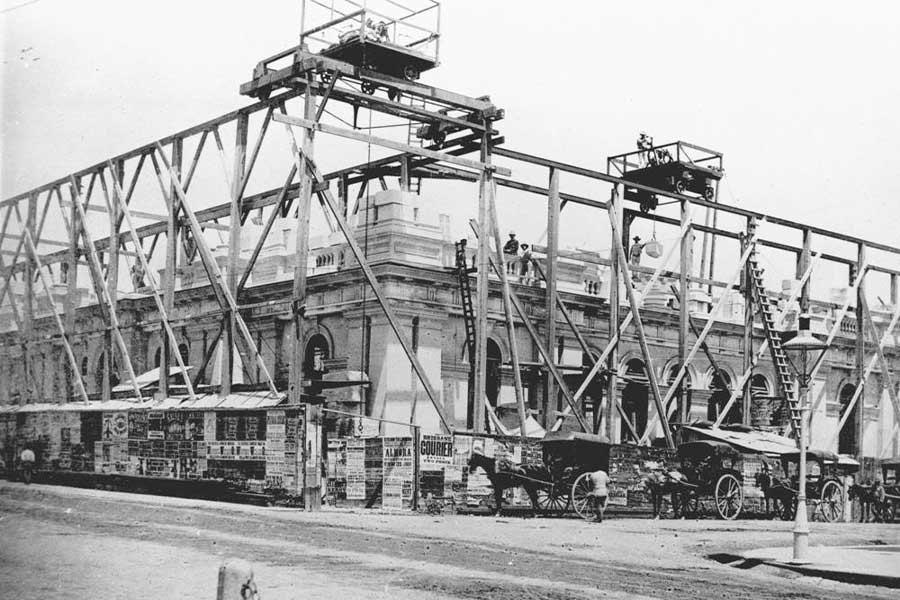
Construction of the Queensland National Bank at 308 Queen Street, Brisbane, in 1883. Image: State Library of Queensland
Construction of the Queensland National Bank at 308 Queen Street, Brisbane, in 1883. Image: State Library of Queensland
After a lengthy process, and a change of architects and building plans, prominent Queensland architect Francis Drummond Greville (FDG) Stanley was chosen to design the building.
Construction was headed by Southhall & Tracey and the foundation stone was laid in 1881. The building was completed in 1885 and served as the head office of the Queensland National Bank.
Marble floors revealed
UQ’s planning and building process of UQ Brisbane City started in 2020. Close to construction beginning, the first discovery was made.
“Buried under tar, lino and layers of carpet was marble from 1885, basically installed with the original bank, under The Atrium,” said Mr du Plessis, Senior Practice Director at BVN.
“It was a wonderful discovery, but quite stained and misused, of course.”
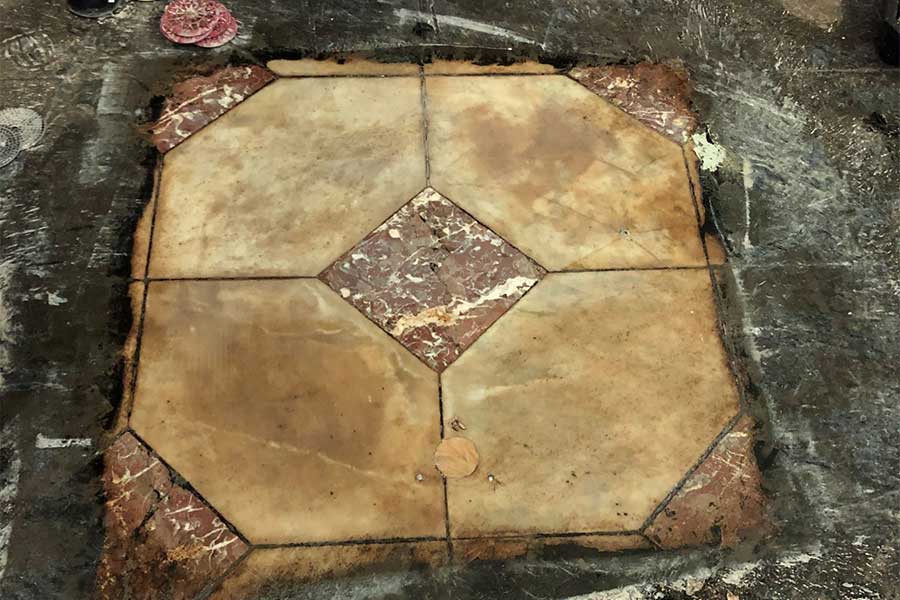
An original marble floor was discovered hidden under tar, lino and layers of carpet. Image: Conrad Gargett
An original marble floor was discovered hidden under tar, lino and layers of carpet. Image: Conrad Gargett
“We spent a lot of time and effort refurbishing the marble; a poultice was applied to remove all the staining, as well as polishing and inserting new pieces of marble to fix and make it worth using now.”
It is assumed that the marble hidden under layers of adhesive was purchased by Lt-Colonel ER Drury, the Bank's General Manager, while he was in the United Kingdom during 1883 to 1884.
Over years of use and ample foot traffic, the marble floor had been unknowingly damaged. Rather than covering or removing it, UQ engaged specialist contractors to carefully clean and restore the 1880s marble floor to its former glory, while carefully acknowledging its battle scars.
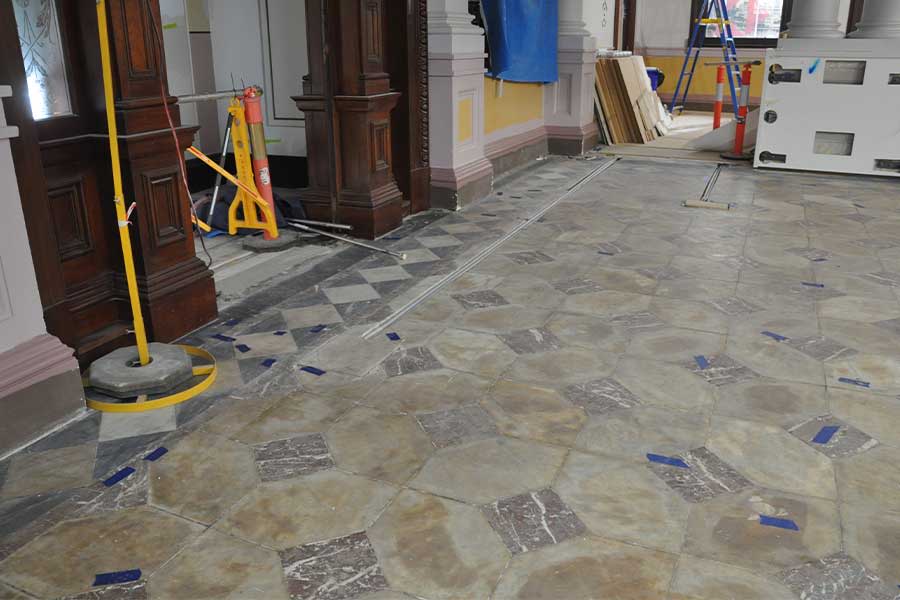
A lot of time and effort was spent refurbishing the marble, with a poultice applied to remove all the staining. Image: Conrad Gargett
A lot of time and effort was spent refurbishing the marble, with a poultice applied to remove all the staining. Image: Conrad Gargett
But there were more interesting discoveries to come.
When lifting floorboards in 2021, the team uncovered a selection of artefacts from the tradesmen who worked at the site decades before them.
These included a battery – probably used for a radio or similar – and a beautiful timber handle winder for a security shutter. What’s more, there was wonderfully preserved graffiti scribbled on the wooden boards – a way for those tradesmen to leave a mark on history, with one dating back to 1948.
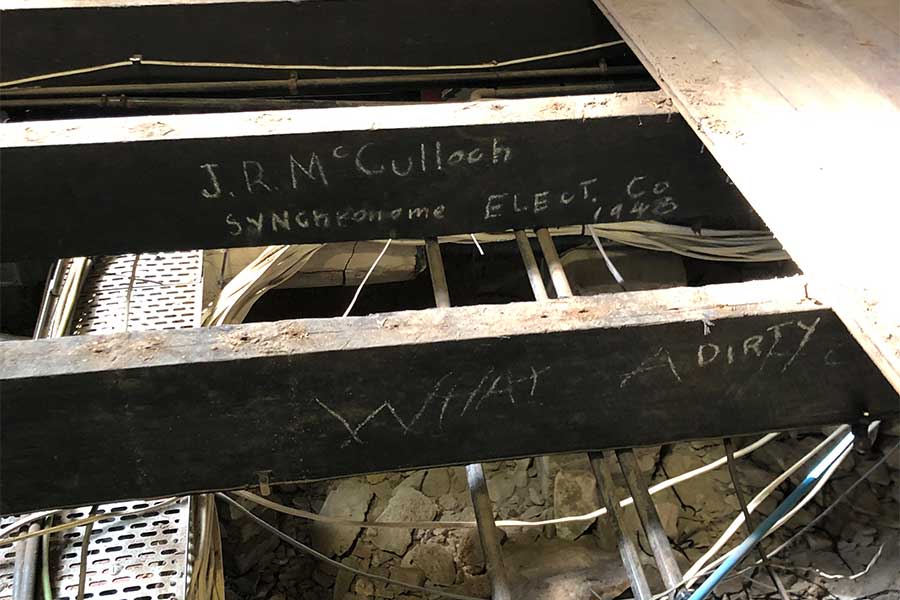
Some of the graffiti scribbled on the wooden boards of the building at 308 Queen Street. Image: Conrad Gargett
Some of the graffiti scribbled on the wooden boards of the building at 308 Queen Street. Image: Conrad Gargett
Heritage architect and Senior Associate at Conrad Gargett, Michael Scott, said these discoveries were an interesting time capsule and insight into Brisbane’s construction history.
“The battery was recorded and safely disposed of, while the security shutter handle is with the builder FDC and we’re hoping it can be re-instated in its original location as a historical display item in the Long Room,” he said.
“These discoveries remind us that the building has been maintained and changed in detail over its 137-year history.
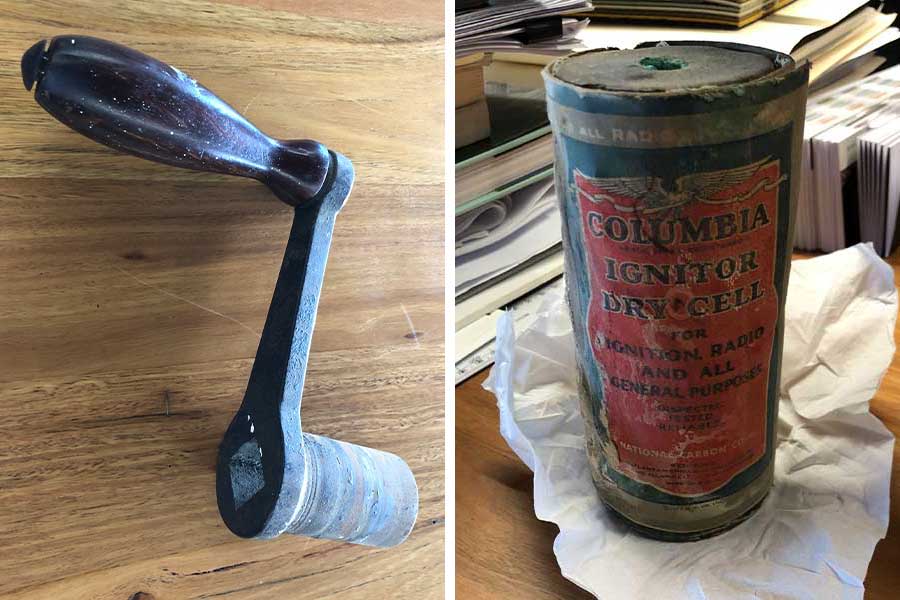
A timber handle winder and a battery were some of the artefacts discovered during the restoration process. Images: Conrad Gargett
A timber handle winder and a battery were some of the artefacts discovered during the restoration process. Images: Conrad Gargett
“For example, a passenger lift was inserted into the main staircase in the late 19th century, the Banking Chamber was significantly expanded in the 1920s and The University of Queensland’s recent refurbishment of the building sees it heading in a new direction for the foreseeable future.
“The adaptive re-use of this heritage building is my favourite sort of work, combining the best of the past with good-quality new design to achieve an exceptional architectural outcome, full of rich 19th century detailing and contemporary style and functionality.”
The dome as a reference point
Mr du Plessis said his favourite aspect of the new space was also the integration of history within the new design.
The incredible dome in The Atrium is believed to be the only one of its kind left in Queensland and is reminiscent of the dome in the famous Plaza Hotel in New York City.
However, it is in fact The Atrium’s second dome, with the taller original replaced by the current curved glass dome in the extensive additions and remodelling of the Banking Chamber in the 1920s. The original was a crimson and violet stained-glass dome, and the design process took inspiration from this set of colours.
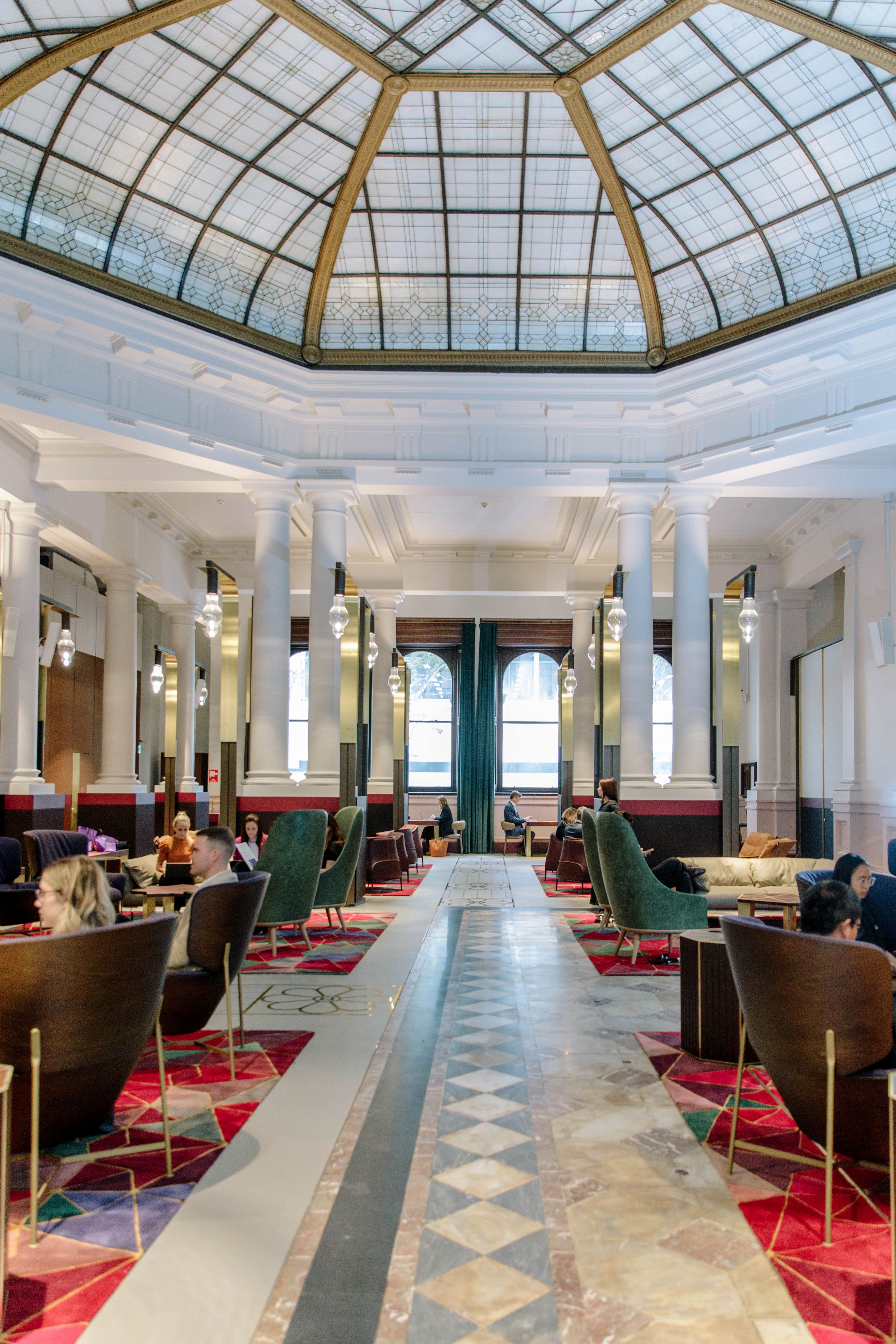
The dome and marble floor are just some of the architectural highlights of The Atrium at UQ Brisbane City.
“We found wonderful reciprocity between those colours and the colours of UQ,” Mr du Plessis said.
“We thought there was a wonderful history there and we wanted to make reference to the dome.
“It was also a wonderful thing to refer to in terms of its geometry – an octagon that turns into a dome, with several octo-squares and octo-flowers within it. We used these to distribute and make sense of detail throughout the space and the new things that we added.”
Mr du Plessis said the geometric shapes from the existing dome design were reworked and became an integral part of decision-making for the new design, with geometric shapes incorporated into the carpet, tables and benches.
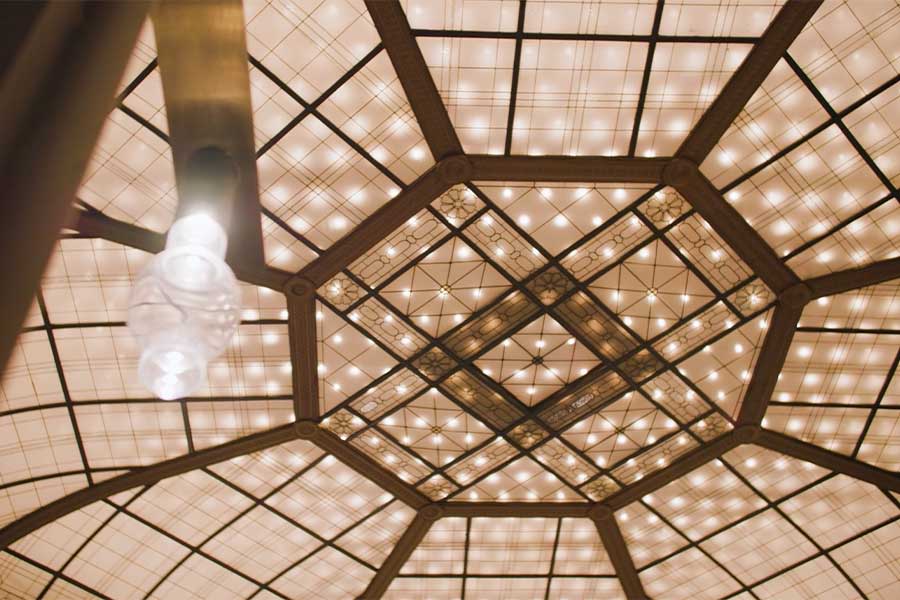
The geometric shapes of the dome are incorporated throughout the design of The Atrium.
The geometric shapes of the dome are incorporated throughout the design of The Atrium.
“A lot of work has been done to reference the original parts of the building to make them come to life and expand on their repertoire,” he said.
“The little details sprinkled throughout have given us a great sense of joy and we’ve had a lot of fun making them. We hope people will notice them and take pride in them.”
Honouring those who served in wartime
After World War I and II, Roll of Honour boards were installed in the bank to remember the employees who served and died in the wars. These boards are still on display in the building – a commemoration and reflection of Australia’s history that UQ will maintain.
Mr du Plessis said that as the building is State Heritage-listed, his team worked with the Department of Environment and Science (DES) to discuss what elements could be moved, removed, or had to stay intact.
“The Roll of Honour boards represent a significant part of the building’s history, and it was appropriate that these be kept in place,” Mr du Plessis said.

The dome and marble floor are just some of the architectural highlights of The Atrium at UQ Brisbane City.
The dome and marble floor are just some of the architectural highlights of The Atrium at UQ Brisbane City.

Your new hang-out space in the city
UQ Brisbane City’s presence, especially The Atrium at 308 Queen Street, was built with the concept of ‘connection’ at the front of mind.
“The Atrium has always been understood and designed as a space for connection in Brisbane’s CBD,” Mr du Plessis said.
“The idea of the public room is a beautiful architectural concept and one that we return to quite regularly in terms of talking about the interaction and the transition between public and private space.
“What’s been created here is essentially a new public room for the city, a contribution by UQ, to the relationship between people in the city.
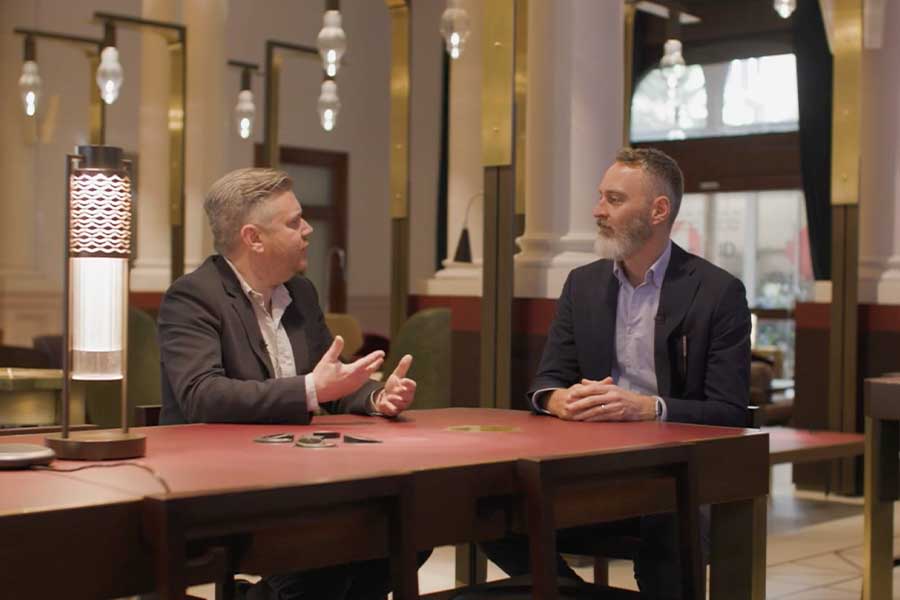
Head of School and Dean, UQ School of Architecture, Professor Cameron Bruhn with lead architect and Senior Practice Director at BVN James du Plessis.
Head of School and Dean, UQ School of Architecture, Professor Cameron Bruhn with lead architect and Senior Practice Director at BVN James du Plessis.
As a UQ alum, Mr du Plessis said it’s wonderful to imagine being able to come here and bump into other architectural professionals and alum working within Brisbane City.
Fellow UQ alum Damian Vassallo (Master of Business Administration ’07) agrees and is looking forward to using the space while between meetings in the CBD.
“I’ll use The Atrium as a base when I’m in town," Mr Vassallo said.
“It's advantageous when I'm between meetings, and I will also conduct lunch and learns in the meeting rooms for my city-based clients shortly.”
“The architecture and interior design are world-class. For visitors, it provides a sense of professionalism and a unique experience to meet in town. As a UQ experience, I believe it will invigorate many folks' connections with the University.”

As a former bank, the building was traditionally a very private, closed space – away from the eyes of the public. But through this restoration, UQ is reopening the doors – quite literally – to welcome the UQ community.
“This restoration has been a fundamental change in the building’s history. It’s now an open space for people to roam, as opposed to the bank which was closed and ‘secretive’,” Mr du Plessis said.
“It's wonderful to imagine the life of the building for the next 50 years and how the occupation of the University can facilitate more people accessing this space.
“It's now a space for everyone to be able to come and enjoy.”
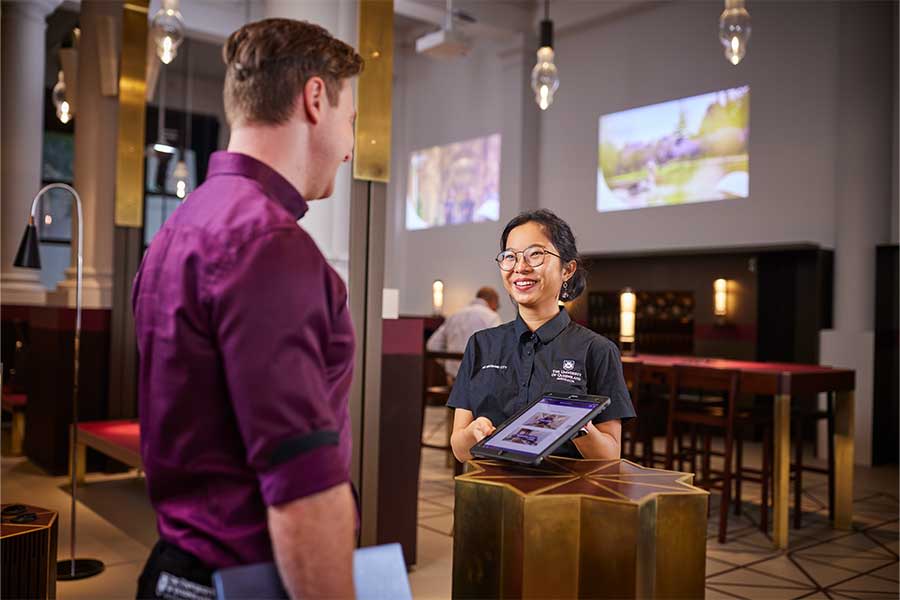
Visit The Atrium today
The Atrium is open from 7am–7pm, Monday to Friday, and all UQ alumni are welcome. Walk-ins to the co-working space are encouraged and the concierge team will greet you on arrival, assist with guest check-in, and help you settle in.


